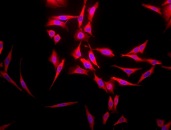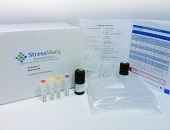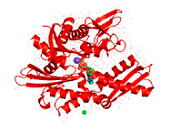HSP70: Regulation
When cells are subjected to environmental stress, they respond by enhancing expression of HSPs. The rapid induction of HSP in response to environmental stress is based on a variety of genetic and biochemical processes referred to as the heat shock response (HSR)
107. Only the expression of three members of the HSP70 family is induced by stress including Hsp70-1 (HspA1A). HSR is regulated mainly at the transcription level by heat shock factors (HSF). HSFs are transcription factors that bind specific cis-acting sequences upstream of the heat shock gene promoters called heat shock elements (HSE)
108. Among them, HSF-1 is considered as being the key transcription factor of stress-inducible HSPs
109, 110. Like any other transcription factors, HSFs are modular proteins composed of several functional domains, including a DNA-binding domain (DBD) and two oligomerization domains (HR-A/B) at the N-terminus, a third oligomerization motif (HR-C) and an activation domain at the C-terminus, and one or more regulatory domains intermingled to these. DBD consists of helix-turn-helix motifs which form compact globular structures that regulate DNA binding and target gene recognition
111. In contrast, the hydrophobic heptad repeat (HR)-A/B domains mediate both spontaneous and inducible oligomerization of HSF-1, by forming a coiled coil conformation typical of leucine zipper-containing proteins
112. Under non-stress conditions, HSF-1 exists as an inactive monomer in the cytoplasm due to intramolecular bonds between HR-C and HR-A/B domains and its association with Hsp70 and Hsp90
109. In response to stress, HSF-1 is released from Hsp70 and Hsp90 proteins forming homotrimers that bind to HSEs upon phosphorylation (for a review see Zorzi and Bonvini
112). HSF-1 binding to HSEs in the promoter of HSP70 triggers release of RNA polymerase II from the preinitiation complex followed by initiation of the elongation phase
113. As already mentioned, constitutive high levels of Hsp70-1 are frequently observed in cancer cells, in which the chaperone confers resistance to stress-induced apoptosis, serves in suppression of default senescence, and is associated with metastasis development and drug resistance. In tumors, Hsp70-1 may be also expressed irrespectively of HSF-1 transcriptional activity, consistent with the notion that different factors other than HSF-1 may regulate Hsp70-1 expression and activity
114. Possible candidates for Hsp70 synthesis in the absence of stress comprise the transcription factors STAT (signal transducer and activator of transcription) -1/3 and nuclear factor of IL-6 (NF-IL6) / CCAT/enhancer-binding protein (C/EBP)
115, 116, as inhibition of both STAT and NF-IL6 activity reduces basal Hsp70 expression in HSF-1 deficient tumor cells or cells expressing a defective protein
114, 117, 118. While STAT-3 binds to
HSP70 promoter sequences different from HSEs and competes with HSF-1 for Hsp70-1 expression on stress
119, 120, STAT-1 induces Hsp70-1 expression by recognizing different elements in the promoter region (termed GAS, interferon-gamma activated sequences), and does not compete with HSF-1 for transcription
121. On the one hand, NF-IL6 proteins such as C/EBP recognize STAT-responsive elements and cooperate with HSF-1 for inducing Hsp70-1
120, and on the other hand they can also bind to
HSP70 proximal promoter regions together with STATs thereby stimulating Hsp70-1 transcription regardless of stress
122, 123. Recent investigations identified the mammalian target of rapamycin kinase 1 (mTORC-1)
124, the deacetylase and longevity factor SIRT-1
125 and ΔNp63α, a member of the p53 family
126 as putative cancer-related HSF-1 regulators in tumors contributing to Hsp70-1 overexpression by stimulating HSF-1 expression and/or activity.
It has been shown previously that several inflammatory mediators and signaling molecules such as NF-κB and TNF are strictly bound to chaperone / HSPs gene expression and protein functions. In this context, the NF-κB subunit p65/RelA functions as a transcription factor for numerous HSPs including Hsp70-1 127, 128, 129 that in turn may have antiapoptotic functions in cancer cells 130, 131.
Studies on regulation of HSP translation are infrequent. Recent investigations demonstrated an alteration of gene translation in cancer as a result of changes in microRNA (miRNA) levels accompanying malignant transformation and progression 132, 133. miRNAs are a class of small RNAs that posttranscriptionally regulate gene expression critically involved in transformation, differentiation and proliferation. In mouse cardiac tissues, miRNA-1, miRNA-21 and miRNA-24 have been found to activate HSF-1 and Hsp70-1 levels after exposure to ischemia 134. Little is known about the posttranslational processing of HSP70s. Although some of the amino acid residues have been found to be phosphorylated, their effect in Hsp70 function remains unclear. It has been shown previously that phosphorylation of Hsp70-1 on S400 located close to a nuclear exporting sequence is critical for the nuclear location of the chaperone 135. It is interesting to note that in differentiating erythroblasts from patients with myelodysplastic syndromes in which the nucleocytosolic trafficking of Hsp70-1 is blocked, a constitutively phosphorylated Hsp70-1 mutant is able to restore Hsp70’s cytosolic-nuclear shuttling thereby protecting differentiating erythroblasts from apoptosis 135.




